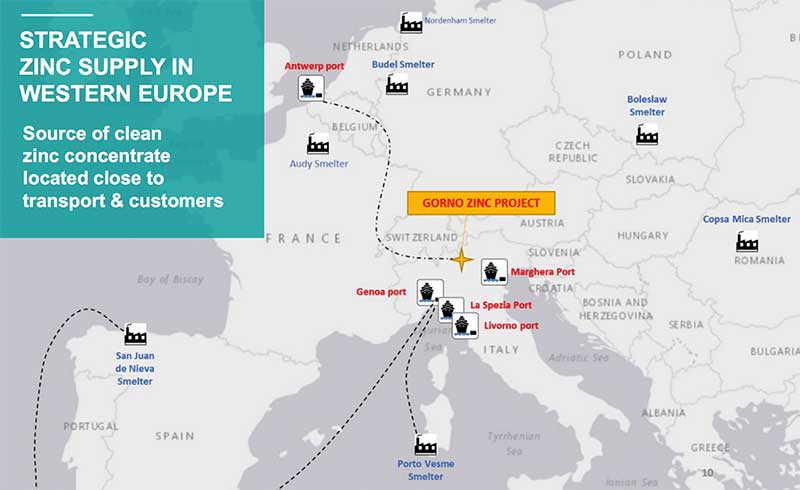You might be interested in
News
Market Highlights: Iron ore, copper rally, oil skids 3pc; and Aussie Defence gets $50bn boost
News
Closing Bell: ASX dragged down by ex-divvy stocks as banks take lead; Gold's rally relentless
News
Mining
The starting point for most mining investments is the appeal of the commodity (is the price going up or down?), followed by the prospect (can it be mined?).
But there is a third critical element often overlooked, people – and that should not be the case with Alta Zinc.
Once known as Energia Minerals, the track record of Alta has not been impressive. (Unless you count an 88 per cent share price fall over the past 18 months, which is certainly impressive — albeit in a negative way.)
That plunge from 5c early last year to latest trades at 0.6c was the result of the company’s struggle to find a commercial development solution for its prime asset, the historic Gorno zinc project in the north of Italy — a region better known for its scenic views of the Swiss and Italian Alps, idyllic lifestyle and truffles (delicious).
Gorno has been a nuisance for everyone involved, including Euroz, a Perth-based stockbroking firm which in 2016, was recommending the stock as a speculative buy with a price target of 11.5c because the firm’s analysts were “confident the project will be viable commercially and technically”.
Interestingly, recent developments at Alta might help the company restore some of its lost value.
While a price of 11.5c might be a stretch, there is probably more upside than downside, which could be a reason why it has attracted a remarkably high-powered private investment group.
Fresh capital
Arete Capital Partners, a Melbourne-based private equity group, struck a strategic alliance with Alta earlier this year, tipping in a handy $3 million in fresh capital and providing some of its executives for an advisory panel.
It’s the people on the panel who are interesting.
Hugh Morgan, a former chief executive of Western Mining Corporation before it was acquired by BHP, is one member of the Arete team advising Alta. Alta is valued on the stock market at $8.2 million, which is fraction of the billions of dollars normally associated with people like Morgan.

Peter Johnston, a senior Glencore executive (and another former WMC man) is also a member of the Arete team advising Alta. There’s also Graham Brown, a former head of exploration for Anglo American PLC, and Shaun Treacy, a former head of the European metals and mining division of the big US bank JP Morgan.
The four Arete advisers on the Alta panel have the skills to advise the world’s biggest mining companies, let only an $8.2 million mining minnow, which leads back to the point about the importance of looking at management of an investment opportunity as closely as the commodity and prospect.
Redevelopment of zinc mine
What the Arete team sees in Alta is pretty much what the company’s founder, Alex Burns saw several years ago when he got involved, tipping in a small portion of the $500 million he made when selling an iron ore prospect in Africa to Xstrata, before it merged with Glencore.
The plan remains the re-development of a zinc mine, with its associated lead and silver, which was last worked more than 30 years ago when part of the Italian national oil company ENI.
As has been demonstrated repeatedly, the mixing of minerals and oil is rarely successful. Oil companies largely abandon their mineral investments while miners quit all or some of their oil. BHP’s exit from US onshore oil is a recent example.
At Gorno, ENI wasn’t happy with zinc mining, walking away to leave the challenge to someone else.
Enter Burns and Energia with a plan that didn’t quite work; and now enter the Arete team to see if decades of mine management experience can deliver what looks to be a project poised to capitalise on strong demand for zinc — even of the price has slipped from recent highs.

The first indication that Arete’s involvement is having an effect on Alta came last week when the company released a fresh presentation on its plans for Gorno.
While little has changed in the target (zinc and lead) or the end market (European metal smelters) the way ahead looks a little different with a fresh feasibility study underway focused on a low-cost start and future possible expansion – what might be called walk-before-you-run.
In theory, the orebody at Gorno could be what Alta calls the tip of the iceberg.
The feasibility study is based on a first stage — mining a resource of 3.3 million tonnes of material grading a combined 6.2 per cent zinc and lead with a production start in 2020.
That would be followed by expansion based on exploration results which point to opportunities in several directions.
Seasoned investors will know the Gorno story, the project’s history, location and past attempts to pick up where ENI’s mining arm, Samim, left off.
They will also know that breathing life back into Gorno has not been easy.
Less well known is the involvement of Arete and its high-powered team of experts with a deep experience of mining — and the added incentive of Arete to at least restore value to the $3 million invested in April in exchange for a parcel of Alta shares at 1.1c each.
That 1.1c issue price to Arete is close to double where Alta’s shares are trading today and is a target for new Alta investors if for no other reason than the desire of the Arete team to recoup its initial outlay.